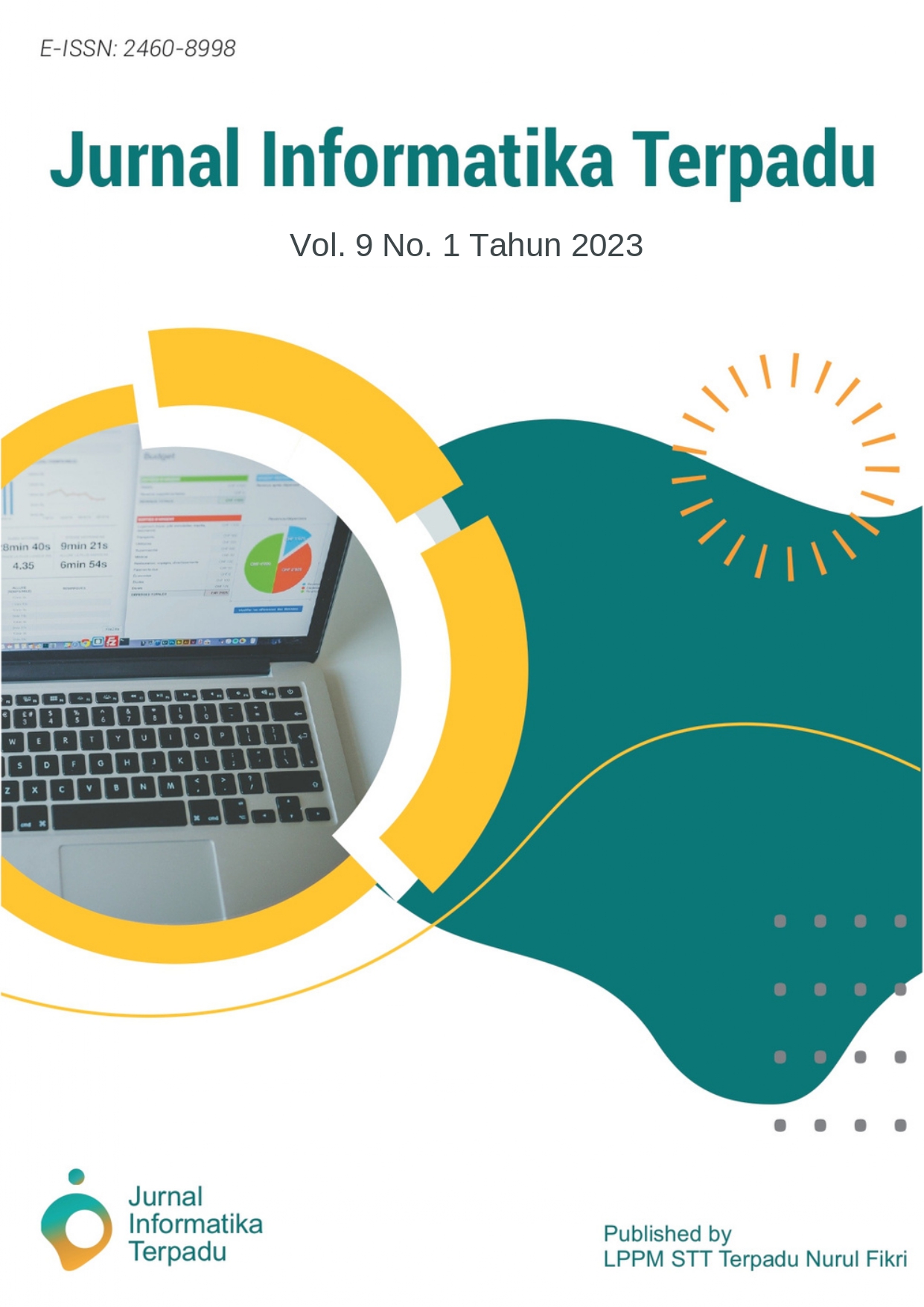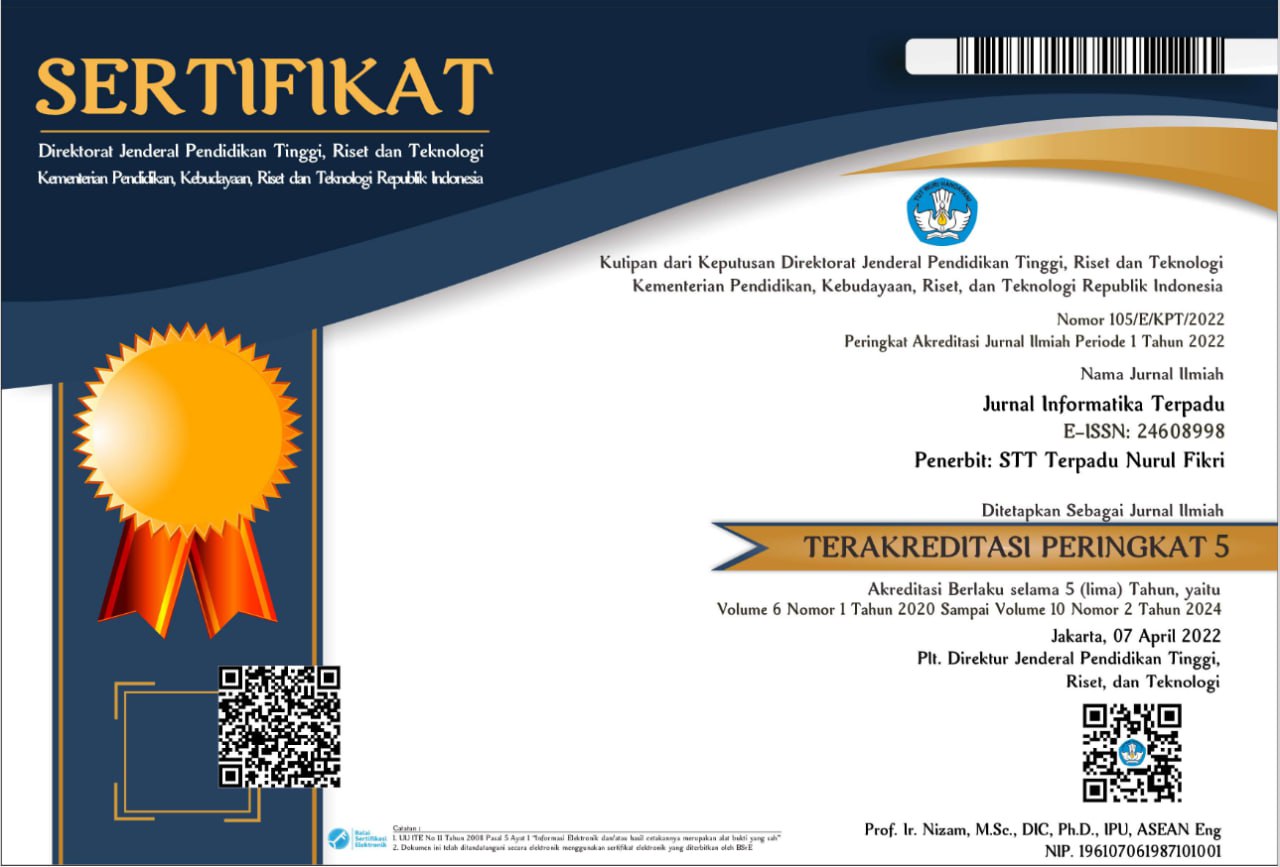Telemedicine pada Layanan Tuberkulosis (Literature Review)
DOI:
https://doi.org/10.54914/jit.v9i1.626Kata Kunci:
Layanan Kesehatan, Telemedicine, Terapi DOT, Tuberkulosis, VideoAbstrak
Pandemi Covid-19 saat ini telah membatasi pergerakan masyarakat untuk mengakses layanan kesehatan. Hal ini mengakibatkan berkurangnya akses terhadap pengobatan tuberkulosis dan telah mengakibatkan peningkatan kematian. Saat ini, pemerintah telah menganjurkan penggunaan alat dan teknologi digital seperti telemedicine untuk perawatan pasien. Tujuan penelitian ini untuk mengetahui bagaimana penerapan telemedicine pada layanan tuberkulosis. Studi ini menggunakan metodologi Systematic Literatur Review dengan sumber data publikasi artikel ilmiah dari database Google Scholar, PubMed, ScienceDirect, dan ProQuest. Berdasarkan 6440 artikel yang diperoleh pada awal pencarian, pada akhirnya didapatkan 18 artikel yang memenuhi kriteria inklusi dan ekslusi penelitian ini. Hasil pelaksanaan implementasi telemedicine dalam pelayanan tuberkulosis dilakukan dengan menggunakan terapi DOT (Direct Observation Treatment) menggunakan Video atau vDOT (Video Direct Observation Treatment), ketika kegiatan telemedicine lainnya dilakukan melalui telepon langsung, pengiriman pesan teks suara secara berkala untuk pengingat pasien, vDOT dilakukan secara sinkronis melalui unggahan atau asinkron melalui perekaman video. Platform telemedicine bermanfaat bagi tenaga kesehatan dalam menanggulangi dan mencegah tuberkulosis yang memerlukan pengawasan intensif pada pasien, sehingga pasien dapat dipantau secara teratur, mengurangi pasien putus obat dan meningkatkan keberhasilan pengobatan tuberkulosis. Terdapat peluang untuk pembangunan aplikasi telemedicine di Indonesia yang berfokus pada penggunaan vDOT.
Unduhan
Referensi
G. K. L. Huang et al., “Telemedicine in Resource-Limited Settings to Optimize Care for Multidrug-Resistant Tuberculosis,†Front Public Health, vol. 7, Aug. 2019, doi: 10.3389/fpubh.2019.00222.
Global Tuberculosis Report 2021. [Online]. Available: http://apps.who.int/bookorders.
A. J. Bokolo, “Application of telemedicine and eHealth technology for clinical services in response to COVID 19 pandemic,†Health Technol (Berl), vol. 11, no. 2, pp. 359–366, Mar. 2021, doi: 10.1007/s12553-020-00516-4.
M. L. Donahue, M. D. Eberly, and M. Rajnik, “Tele-TB: Using TeleMedicine to Increase Access to Directly Observed Therapy for Latent Tuberculosis Infection,†Mil Med, vol. 186, pp. 25–31, Jan. 2021, doi: 10.1093/milmed/usaa300.
P. Bachina et al., “Programmatic Adoption and Implementation of Video-Observed Therapy in Minnesota: Prospective Observational Cohort Study,†JMIR Form Res, vol. 6, no. 8, Aug. 2022, doi: 10.2196/38247.
L. H. Nguyen et al., “Assessing private provider perceptions and the acceptability of video observed treatment technology for tuberculosis treatment adherence in three cities across Viet Nam,†PLoS One, vol. 16, no. 5 May, May 2021, doi: 10.1371/journal.pone.0250644.
I. Margineanu et al., “Patients and medical staff attitudes toward the future inclusion of ehealth in tuberculosis management: Perspectives from six countries evaluated using a qualitative framework,†JMIR Mhealth Uhealth, vol. 8, no. 11, Nov. 2020, doi: 10.2196/18156.
G. Fekadu, X. Jiang, J. Yao, and J. H. S. You, “Cost-effectiveness of video-observed therapy for ambulatory management of active tuberculosis during the COVID-19 pandemic in a high-income country,†International Journal of Infectious Diseases, vol. 113, pp. 271–278, Dec. 2021, doi: 10.1016/j.ijid.2021.10.029.
K. D. Gashu, K. A. Gelaye, Z. A. Mekonnen, R. Lester, and B. Tilahun, “Does phone messaging improves tuberculosis treatment success? A systematic review and meta-analysis,†BMC Infect Dis, vol. 20, no. 1, Jan. 2020, doi: 10.1186/s12879-020-4765-x.
K. K. Bommakanti et al., “Requiring smartphone ownership for mHealth interventions: Who could be left out?,†BMC Public Health, vol. 20, no. 1, Jan. 2020, doi: 10.1186/s12889-019-7892-9.
J. Hodges et al., “Implementation of a Mobile Health Strategy to Improve Linkage to and Engagement with HIV Care for People Living with HIV, Tuberculosis, and Substance Use in Irkutsk, Siberia,†AIDS Patient Care STDS, vol. 35, no. 3, pp. 84–91, Mar. 2021, doi: 10.1089/apc.2020.0233.
Y. Bao et al., “Effect of mHealth intervention for pulmonary tuberculosis self-management based on the Integrated Theory of Health Behavior Change (ITHBC): a randomized controlled trialâ€, doi: 10.2196/preprints.34277.
E. Wijayanti et al., “Mobile application development for improving medication safety in tuberculosis patients: A quasi-experimental study protocol,†PLoS One, vol. 17, no. 9, p. e0272616, Sep. 2022, doi: 10.1371/journal.pone.0272616.
S. Santra, S. Garg, S. Basu, N. Sharma, M. M. Singh, and A. Khanna, “The effect of a mhealth intervention on anti-tuberculosis medication adherence in Delhi, India: A quasi-experimental study,†Indian J Public Health, vol. 65, no. 1, pp. 34–38, Jan. 2021, doi: 10.4103/ijph.IJPH_879_20.
N. Riccardi et al., “How to improve TB outpatient service in a TB low-endemic country during SARS-CoV-2 pandemic,†Journal of Preventive Medicine and Hygiene, vol. 62, no. 1. Pacini Editore S.p.A./AU-CNS, pp. E50–E52, Jun. 01, 2021. doi: 10.15167/2421-4248/jpmh2021.62.1S3.2008.
G. R. Beeler Asay et al., “Cost of tuberculosis therapy directly observed on video for health departments and patients in New York city; san francisco, California; and rhode island (2017-2018),†Am J Public Health, vol. 110, no. 11, pp. 1696–1703, Nov. 2020, doi: 10.2105/AJPH.2020.305877.
S. W. Ng et al., “Assessing the Availability of Teleconsultation and the Extent of Its Use in Malaysian Public Primary Care Clinics: Cross-sectional Study,†JMIR Form Res, vol. 6, no. 5, May 2022, doi: 10.2196/34485.
A. Zhao, N. Butala, C. M. Luc, R. Feinn, and T. S. Murray, “Telehealth Reduces Missed Appointments in Pediatric Patients with Tuberculosis Infection,†Trop Med Infect Dis, vol. 7, no. 2, Feb. 2022, doi: 10.3390/tropicalmed7020026.
K. K. Katende et al., “Design, development, and testing of a voicetext mobile health application to support Tuberculosis medication adherence in Uganda,†PLoS One, vol. 17, no. 9 September, Sep. 2022, doi: 10.1371/journal.pone.0274112.
Mp. J. S. M. M. Lila Rabinovich, “Perceptions and Acceptability of Digital Interventions Among Tuberculosis Patients in Cambodia: Qualitative Study of Video-Based Directly Observed Therapy,†J Med Internet Res., 2020.
Unduhan
Diterbitkan
Cara Mengutip
Terbitan
Bagian
Lisensi
Hak Cipta (c) 2023 Siti Muhimatul Munawaroh, Vetty Yulianty Permanasari

Artikel ini berlisensiCreative Commons Attribution-ShareAlike 4.0 International License.












